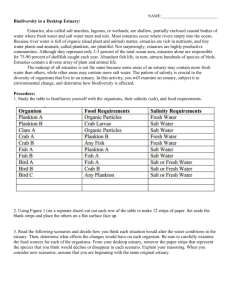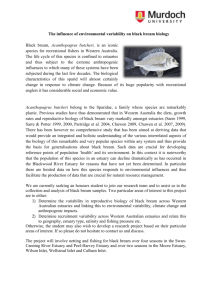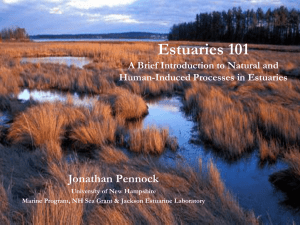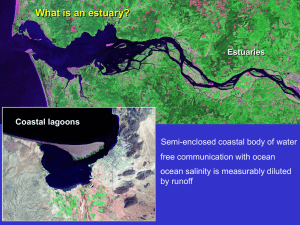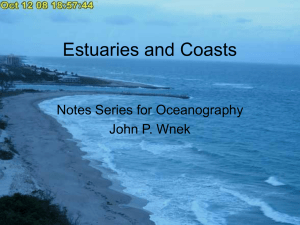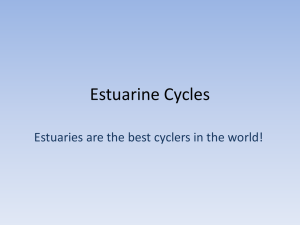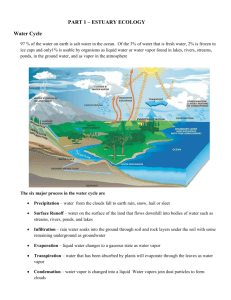Estuaries - MUGAN`S BIOLOGY PAGE
advertisement
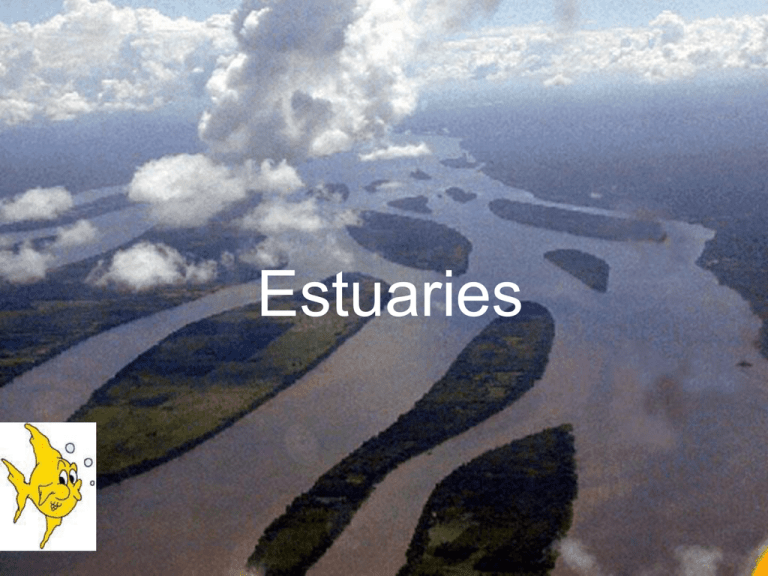
Estuaries What is an estuary, you may ask? An estuary is the area where a river and an ocean meet. Video all about estuaries http://www.untamedscience.com/biology/w orld-biomes/estuaries-biome Estuaries can be found all over the world, but are constantly changing. In an estuary the water is a mixture of salt water, that is different than the ocean, and freshwater, that is different from the river, which makes the estuary very unique. Weather The rainfall for an estuary varies on where it is located. Rainfall The estuaries of the southwest have very high rainfall Most east coast estuaries are subject to low rainfall Rainfall for the southeast estuaries are seasonal often with very dry summers The estuaries of the north coast are classified by seasonal rainfall Bass Straight Estuaries in the north coast have seasonal rainfall rainfalls are seasonal. The temperature of an estuary greatly varies because of how shallow it is. Temperatures for an estuary can vary on a yearly basis, or even a daily basis. Some estuaries at high temperatures can even have ice on the surface. Both prevailing winds and tidal currents can greatly affect the surface temperature of an estuary. Seasonal changes can most easily be detected in the coastal regions in the midlatitude where surface temperatures are at a minimum in winter and a maximum in late summer. The winds of an estuary depends on where it is located. But no matter where the estuary is located, wind plays an important role. Persistent winds can move large volumes of water to one side of the estuary and raise the water level along the downwind shoreline. Gravity soon sets in and the water begins to flow in the opposite direction along the bottom. Similarly, the water level along the upwind shoreline may fall as the wind blows the water off shore. Strong winds that blow across estuaries can cause nontidal circulation. In simpler terms the friction between the wind and the water creates extra movement. Geology The soil type of an estuary is very rich and full of nutrients. You are probably wondering what makes the soil so rich and full of nutrients? Well there are many animals and plants that die and decay which cause the high amount of nutrients in the soil. Because of the nutrients in the soil, a large variety of plants are able to live in estuaries. Like most other factors, depending on where the estuary is located, determines the type of terrain it will contain. Estuarine habitat types include sandy substrate, rocky shores and reefs, soft-sediment bottoms, cobbled areas, seagrass beds, salt marshes, intertidal mudflats, and other vegetated wetland areas. Douglas Aster Pickleweed Red Algae To be able to live in an estuary, plants have to make special adaptations. The ebb and flow of tides may leave some plants high and dry, so they have to be able to accommodate Tufted Hairgrass The plants that live in estuaries are naturally able to adapt to the conditions that they are provided with. Gumweed The ranging temperatures leave the plants in a variety of positions. They live in freezing and very warm temperatures. Harbor Seal Animals River Otter Greater Yellowlegs Animals that live in estuaries have to learn to adapt to the range in temperatures and the unique salt and fresh water levels. Hermit Crab The shallow water, salt marshes, seagrasses, and mangrove roots provide excellent hiding places from larger, open-water predators. Some species grow in estuaries for a short time; others remain there for life. Chum Salmon Many fishes and crustaceans migrate offshore to spawn or breed. The eggs develop into larvae (immature forms) that are transported into estuaries by tides and currents. Since an estuary habitat is mostly water, a majority of the animals found there have gills, or are able to survive in and around the water. The oysters that live in estuaries serve as a shelter for parasites and other bacteria that live there too. Works Cited http://www.ucmp.berkeley.edu/exhibits/biomes/marine.php http://depts.washington.edu/natmap/water/estuary_animals.html http://www.gma.org/katahdin/estuary.html http://soer.justice.tas.gov.au/2009/indicator/39/index.php http://www.nhptv.org/natureworks/nwep6a.htm http://core.ecu.edu/geology/woods/estuariesI.htm http://www.waterencyclopedia.com/En-Ge/Estuaries.html http://images.google.com/images?rlz=1T4RNWN_enUS301US304&q=estuary%20worm&safe=active&um=1&ie=UTF8&source=og&sa=N&hl=en&tab=wi http://images.google.com/images?um=1&hl=en&safe=active&rlz=1T4RNWN_enUS301US304&tbs=isch%3A1&ei=LurZS8_YDY7M7ankVI&sa=X&oi=spell&resnum=0&ct=result&cd=1&q=pickleweed&spell=1&start=0 http://www.lizasreef.com/hope%20for%20the%20oceans/Images%20HFTO/estuaries.jpg http://www.dep.state.fl.us/coastal/habitats/estuaries.htm http://images.google.com/images?rlz=1T4RNTN_enUS359US375&q=river%20otter&safe=active&um=1&ie=UTF8&source=og&sa=N&hl=en&tab=wi http://images.google.com/imgres?imgurl=http://www.grayling-on-a-fly.com/images/chum-salmon.jpg&imgrefurl=http://www.graylingon-afly.com/fishing.html&usg=__KFV9RT7fnE0PQqSDWm9whI5O2Vk=&h=380&w=950&sz=67&hl=en&start=1&um=1&itbs=1&tbnid=8iN pg5A70S7btM:&tbnh=59&tbnw=148&prev=/images%3Fq%3Dchum%2Bsalmon%26um%3D1%26hl%3Den%26safe%3Dactive%26rl z%3D1T4RNTN_enUS359US375%26tbs%3Disch:1 http://www.niot.res.in/m5/mbic/me/zones/images/estuary_clip_image001.jpg http://www.thefreelibrary.com/Parasitic+and+symbiotic+fauna+in+oysters+(Crassostrea+virginica)...-a0130777669 http://www.bing.com/images/search?q=geology&FORM=BIFD# http://www.bing.com/images/search?q=estuary%27&go=&form=QBIR&qs=n&sk=&sc=88#focal=77ffb4f1044ed2484700c7f67dd01776&furl=http%3A%2F%2Fwww.co.snohomish.wa.us%2Fdocuments%2FDepartments%2 FParks%2Fmaps%2Festuary_map.jpg

